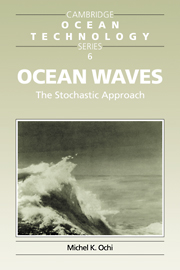Book contents
- Frontmatter
- Contents
- Preface
- 1 Description of random seas
- 2 Spectral analysis
- 3 Wave amplitude and height
- 4 Wave height and associated period
- 5 Sea severity
- 6 Estimation of extreme wave height and sea state
- 7 Directional characteristics of random seas
- 8 Special wave events
- 9 Non-Gaussian waves (waves in finite water depth)
- Appendix A Fundamentals of probability theory
- Appendix B Fundamentals of stochastic process theory
- Appendix C Fourier transform and Hilbert transform
- References
- Index
1 - Description of random seas
Published online by Cambridge University Press: 15 October 2009
- Frontmatter
- Contents
- Preface
- 1 Description of random seas
- 2 Spectral analysis
- 3 Wave amplitude and height
- 4 Wave height and associated period
- 5 Sea severity
- 6 Estimation of extreme wave height and sea state
- 7 Directional characteristics of random seas
- 8 Special wave events
- 9 Non-Gaussian waves (waves in finite water depth)
- Appendix A Fundamentals of probability theory
- Appendix B Fundamentals of stochastic process theory
- Appendix C Fourier transform and Hilbert transform
- References
- Index
Summary
STOCHASTIC CONCEPT AS APPLIED TO OCEAN WAVES
Introduction
The profile of wind-generated waves observed in the ocean changes randomly with time; it is non-repeatable in time and space. In reality, both wave height (peak-to-trough excursions) and wave period vary randomly from one cycle to another. It is often observed that waves break when the wave steepness exceeds a certain limit. Furthermore, during the process of the wind-generated waves traveling from one location to another after a storm, waves of shorter length gradually lose their energy resulting in the wave profile becoming less irregular (this situation is called swell) than that observed during a storm.
A more distinct difference in the wave profile can be observed when the water depth becomes shallow. As an example, Figure 1.1 shows portions of wave profiles recorded in severe seas; one in deep water in the North Atlantic, the other in a nearshore area of water depth 2.1 m. As seen in Figure 1 (a), positive and negative sides of the wave profile in deep water are, by and large, similar, while for waves in shallow water (Figure 1(b)), peaks are much sharper than troughs, and the order of magnitude of the peaks is different from that of the troughs.
- Type
- Chapter
- Information
- Ocean WavesThe Stochastic Approach, pp. 1 - 12Publisher: Cambridge University PressPrint publication year: 1998



